The healing properties of calendula
In folk medicine, the beneficial properties of calendula have been used for a long time - they make lotions, douches, and rinses. This plant promotes wound healing, gets rid of boils and fights teenage acne. With the help of calendula, they treat eczema, lighten the skin of the face, whiten freckles, and get rid of age spots. Calendula infusion is widely used in the treatment of scratches, burns and abrasions. Also, in the treatment of various skin problems, calendula is used in the form of ointments or emulsions.
The medicinal properties of calendula are so extensive that it is also used for fever, malignant tumors and the treatment of the sciatic nerve. With its help, conjunctivitis and mastitis are cured. Calendula is known for its diuretic and diaphoretic properties. Pharmaceutical preparations from calendula are prescribed as a bactericidal agent in the fight against streptococci and staphylococci. In addition, calendula infusion is widely used for stomatitis, sore throat and other oral problems.
The use of calendula in cosmetology
Due to the beneficial properties of calendula, it is successfully used for cosmetic purposes. An infusion of calendula flowers helps cleanse pores and whiten skin color. Masks and compresses with calendula solution for the face are used in the modern beauty industry. They improve the color and tone of the facial skin, the skin becomes soft and velvety.
What else is calendula used for in cosmetology? So:
- calendula for acne - calendula infusion is used for oily skin or acne, as the properties of calendula help narrow pores and reduce sebum secretion;
- calendula for skin whitening - calendula leaves are used for skin pigmentation and discoloration of freckles: in equal proportions, the juice of calendula leaves is mixed with lemon juice, olive oil and red currant juice, wipe the face with a cotton pad in the morning and evening, as a regular facial tonic;
- calendula for rejuvenation - calendula promotes the regeneration of skin cells and has a positive effect on the metabolism in them, so it is recommended to wipe your face with calendula tincture daily, this will allow the skin to constantly renew itself and look fresh and young.
Calendula oil: for health and beauty
Calendula oil is primarily an antiseptic that is commonly used for cuts, bruises, abrasions, insect bites, and to heal cracks. It has no restrictions on use and is suitable for absolutely all skin types, even sensitive skin of babies. Calendula oil is used externally only. It can be added to various facial and hand skin care products (creams, lotions).
The recipe for making calendula oil at home is quite simple, although it is much more convenient to buy it at the pharmacy. And yet, for cooking you will need fresh calendula flowers and olive oil. You need to put 5 tbsp in a glass jar. inflorescences and pour everything thoroughly with half a glass of olive oil. Cover with a lid and leave for two weeks in the refrigerator. It is necessary to shake the contents periodically. After the infusion period has expired, the oil should be strained and stored in the refrigerator.
Calendula oil is great for protecting against harmful UV rays and can help prevent sunburn. It restores the water balance of the skin, qualitatively softens and moisturizes it. The oil should be used before going out into the sun; just apply a few drops to your face and rub in with soft circular movements.
Contraindications to the use of calendula
Calendula has virtually no contraindications for use. But still, side effects occur, for example, due to improper use or overdose. So you need to know and remember some cautions about this plant. Before using calendula internally, you should consult your doctor.
Cautions:
- It is contraindicated to use calendula with some herbs that have a sedative effect, for example, motherwort or valerian;
- It is not recommended to use calendula for people suffering from allergic reactions to asteraceae (for example, daisies or chamomile), as they may experience itching or dermatitis;
- It is contraindicated to use calendula oils for people with cardiovascular insufficiency and low blood pressure;
- Calendula-based preparations are not recommended for children under 12 years of age; use may only be permitted after consultation with a medical specialist;
- During pregnancy, calendula infusion in its pure form is contraindicated for internal use, but external use of calendula ointments and tinctures is not contraindicated. However, you should still consult a doctor to avoid a possible allergic reaction.
Calendula oil has a wide range of beneficial properties and is used in medicine and cosmetology. The substance has high wound-healing, anti-inflammatory, moisturizing, and nutritional properties. Calendula oil is suitable for any skin type. As a result of using the product, the face glows with freshness, surprises with the velvety and healthy appearance of the skin.
general description
Calendula oil is obtained through maceration or extraction. In the first case, the flowers of the plant are infused on a fatty base (mainly sunflower or olive oil). The resulting product has a bright yellow-orange color, a characteristic smell of rotten hay, and a typical liquid, slightly viscous consistency. This is exactly the option can really be done at home. The substance is cheaper and easier to produce, which makes it widely available.
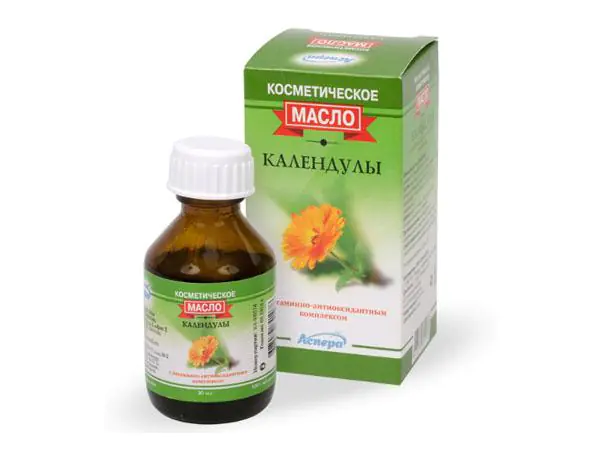
The version obtained during extraction (exposure of the petals to carbon dioxide) differs in the true composition. There are no additives, impurities, or traces of solvent. The product is an ointment-like mass of a dark carmine, orange-brownish hue, with a peculiar herbal odor. It is difficult to find such oil on sale.
Calendula derivatives with an oily texture can be found in cosmetics. Most often, products for problematic, oily skin are “flavored” with the substance. The ingredient is found in soaps, lotions, and creams.
Attention! The substance is considered popular for use in skin care at home and is used for medicinal purposes.
A little history
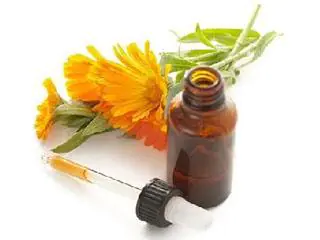
The healing properties of calendula were recognized in ancient times. The first mention of the flower is associated with Ancient Rome. The plant's fame quickly spread throughout the world. Various decoctions, infusions, and extracts were actively used in Ancient Greece, France, China, India, and Russia.
Already in the Middle Ages, people used the “flower of the sun” to treat dermatological problems, ailments of the heart, liver, and gastrointestinal tract.
I loved the flower very much The famous Queen Margot appreciated its beneficial properties. Historians suggest that the unprecedented beauty and attractiveness of a woman was supported by this particular plant.
Composition and beneficial properties
The composition of calendula oil is determined by the method of obtaining the product. A substance produced by the maceration method imparts to a greater extent the properties of the base to the mass. Additionally, the composition contains the following components:
- tannins;
- flavonoids;
- polyunsaturated fatty acids (arachidic, stearic, oleic, palmitic, linoleic);
- carotenoids;
- vitamin C;
- phytoncides;
- natural UV filters.
The extraction product is characterized by a high content of triterpene alcohols, monoesters, and waxes. This determines the consistency of the substance, its strong anti-inflammatory and protective properties.
Calendula oil promotes wound healing, eliminates inflammation, and softens rough skin. Sebum regulation occurs in the tissues, proper blood supply and metabolic processes are restored. Regular use of the substance increases the skin's resistance to various unfavorable conditions (inflammation, damage, disruption of normal functioning).
Indications for use

Calendula oil is suitable for caring for any type of epidermis. Most often, the product is included in a program for restoring dry, damaged skin. The product is often used to improve the condition of oily, problematic skin. The substance will also be useful for sensitive skin.
The product is often used for protection from the sun, frost, and care for epidermis exposed to burns and frostbite. The range of beneficial effects is wide. The following beneficial cosmetic effects are usually identified:
- regulation of the sebaceous glands, absorption of excess sebum, narrowing of pores;
- relief of inflammatory processes in superficial tissues;
- healing of wounds, cracks, peeling, reducing the severity of scar tissue;
- softening and toning of the skin;
- even out complexion;
- elimination of capillary disorders (spider veins, rosacea, dilated veins);
- tissue compaction, protection from the negative effects of adverse external influences (sun, frost, wind, mechanical pressure).
As a result of regular use of oil for skin care, an improvement in the condition of tissues and strengthening of the integument is observed.
Important point! The substance is suitable for everyone without exception. The product is even approved for caring for the vulnerable skin of babies.
Features of purchase and storage
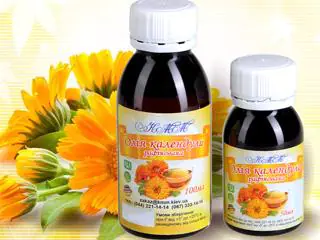
Calendula macerate, the most common version of the oil form of calendula, can be purchased at pharmacies and even supermarkets. When purchasing, you need to pay attention to the integrity of the packaging and check the expiration dates of the substance. The quality of the product largely depends on the base oil used.
The product is stored covered with a lid at room temperature without heating or exposure to light for at least 1–2 years. Concentrated oil extract of calendula is recommended to be stored in a cool place. The shelf life under favorable conditions will be 3–5 years. You can buy this option only in specialized stores or by individual order.
Rules of application
Calendula oil is rarely used in its pure form. It is permissible to apply the substance pointwise to foci of inflammation during the period of exacerbation of the development of the destructive process, for the treatment of wounds, hematomas, protection from cold and sun. Exposure to the entire surface of the skin in its pure form will not cause a burn, but will become an excessively active effect on the tissue for regular use.
The macerate of the plant is usually added to finished cosmetics or introduced into home care products in a concentration of 10–25% of the total mass of the composition. The product goes well with base oils, cypress, lemon, and chamomile esters.
Concentrated oil extract is recommended to be administered in an amount of up to 0.5% of the total mass of the product. The substance is often used in the industrial preparation of cosmetics.
Oil forms of marigolds are not addictive. The product can be used regularly. To eliminate obvious problems (cracks, peeling, acne) procedures are performed daily or with a break of 1–2 days until the desired result is achieved.
Advice. To improve the quality of dry, mature skin, a course is recommended: 2-3 treatments per week for 1-2 months.
Using calendula oil is beneficial regardless of the season. The product is used at any time of the day. The substance can be added to day and night cosmetics. There are no restrictions on skin type or age.
Cosmetologists note that mixing the product with motherwort and valerian is not recommended. This applies not only to oil forms, but also to extracts and alcohol tinctures.
Methods of use
Calendula macerate is often added to industrial or homemade creams, lotions and tonics, lip balms, shampoos, and bath products. The substance can be used for aromatherapy, orally for medicinal purposes. The product can be used in pure or diluted form.
Recipes for facial beauty
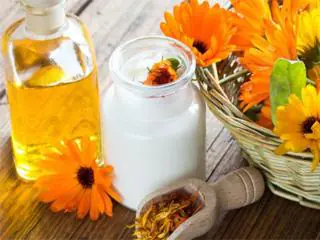
Cosmetologists recommend that owners of problematic (overdried, cracked, inflamed) sensitive skin pay attention to calendula oil. There are recipes to solve various problems:
- To eliminate acne and excess oiliness make a mask with marigold and cocoa oils, which are supplemented with natural aloe extract. Oil components are taken in equal quantities (2 tsp). The homogeneous mixture is heated in a water bath to body temperature. Add 3 tsp to the resulting mass. freshly squeezed aloe juice. The mask is applied to the skin along massage lines. The product is carefully rubbed into the surface for 2-3 minutes. After this, the mask is left for 20 minutes. After a quarter of an hour, the skin is washed off by alternating warm and cold water. It is recommended to treat a clean face with toner and lubricate it with moisturizer.
- For intensive nutrition of very dry, mature skin make a mask with kefir, honey, egg white. Marigold oil in the amount of 1 tsp. heated in a water bath. The same amount of honey is added to the liquid. Add a quarter cup of kefir and the white of 1 egg, lightly beaten with a fork, into the mixture. A homogeneous mixture is distributed over the skin. After 15 minutes, the mask is removed by rinsing with warm water. It is recommended to lubricate clean skin with a rich cream or any suitable base oil.
- To eliminate active peeling and damage make a warm oil compress. Take a gauze napkin, moisten it in hot water, and squeeze it out. The damp cloth is treated with marigold macerate. Gauze is applied to the face for 15–20 minutes. After completing the procedure, remove the fabric and remove excess oil with a dry paper napkin. There is no need to wash your face or additionally treat your face with other means.
- To eliminate the manifestations of rosacea make oil lotions. Mix calendula and grape seed oils in equal quantities (half a teaspoon each). The resulting mass is treated with a cotton pad and applied to the problem area. After 15 minutes, the tampon is removed and the skin is blotted with a napkin. The procedures are repeated daily until positive results are obtained.
Calendula oil tincture will help and in the fight against bruises. Apply the substance carefully, without pressure, to the problem area twice a day. Macerate will be useful when going out into the scorching sun or extreme cold. The oil in the amount of 2-4 drops is simply distributed with soft patting movements over the surface of the integument. The substance will protect against sunburn and frostbite.
Care for lips, eyebrows, eyelashes
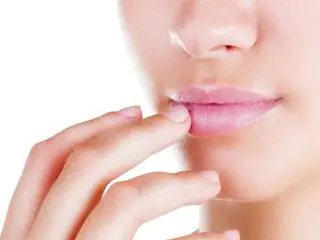
Cosmetologists recommend regular use of marigold macerate to preserve the youth and integrity of lip tissue. The surface is simply treated with oil as needed.
It is acceptable to use the product under balm or lipstick. Cracked lips are lubricated with macerate after each meal until the tissues are completely healed.
Calendula oil is used to care for the hair of eyebrows and eyelashes. The product helps strengthen the hair follicles and make the hairs stronger. Regular oil care will extend the short life cycle of small hairs.
The oil is simply rubbed into the eyelashes and eyebrows, avoiding getting the oily base into the eyes. The substance can be washed off after 15–30 minutes or left overnight. The product must be well absorbed; contact with the mucous membrane of the eyes is not allowed.
Ingestion
Internal use of calendula oil will help in the treatment of diseases of the cardiovascular, digestive systems, gynecology, and skin diseases. Only macerate intended for this purpose is consumed. 1 tsp is enough. 1–2 times a day. Improving the condition of internal organs will have a positive effect on beauty: the complexion will improve, acne and protruding vascular networks will disappear.
Precautionary measures

The main contraindication to the use of oil forms of calendula is called individual intolerance. Before using the product in any form, it is necessary to conduct a sensitivity test to the components. It is recommended to avoid oral administration and procedures with the product if:
- pregnancy;
- heart failure;
- low pressure.
Attention! External use of the product extremely rarely leads to adverse reactions in the body. The substance is approved even for the delicate skin of babies.
Advantages and disadvantages
Calendula oil is a universal product for caring for different skin types. The substance helps eliminate various dermatological problems. The product is characterized by low cost, high efficiency, and the absence of significant contraindications.
Oil forms of calendula are recommended to be used as needed. Continuous regular care will become stressful for untrained skin. It is better to include the substance in a dosage regimen into your care regimen.
Feedback on effectiveness
Calendula oil is often used to care for different skin types. The substance is universal, accessible, and has a positive effect. Most often, the product is useful for treating problem skin and protecting against adverse environmental influences.
I like the result, but expected a greater effect.

I like the sun protection effect.

I like the wound healing effect.

Ideal result for oily skin.

Useful videos
Unique properties of calendula tincture for the skin.
Reviews of the use of calendula for acne indicate a miraculous remedy that helps cure not only acne, but also the consequences of improper treatment - scars, wounds, which results from squeezing out pimples.
Modern cosmetology products do not give such results, since they contain unnatural components. Based on calendula, you can prepare an infusion, decoction, ointment, oil, tincture for acne and for the treatment of problem skin.
Beneficial features
Calendula contains active components that have a beneficial effect on the upper layers of the skin.
Calendula contains:
- carotenoids;
- essential oils;
- flavonoids;
- minerals;
- coumarins.
Carotenoids refresh and tone, suppress the appearance of pimples and blackheads. Essential oils remove toxins.
Flavanoids have anti-inflammatory effects and protect the skin. Coumarins are involved in cell regeneration, and minerals improve the color of the skin and have a rejuvenating effect.
When calendula is applied directly to the pimple itself, the product draws out fat from the subcutaneous tissue and, thus, promotes speedy treatment.
In addition, tinctures, decoctions, and ointments from calendula control the secretion of sebum. Thanks to the astringent function of calendula, the pores become smaller and produce less sebum, which is known to quickly pollute the skin.
Indications
In rare cases, calendula tincture is used to wipe the skin of the face, since alcohol dries out the skin. The tincture is used externally, that is, applied directly to the inflamed area using a cotton swab.
Cosmetologists have not identified any particular contraindications to the use of calendula products, but it is important for each of us to pay attention to some restrictions.
- Open wound. It is strictly contraindicated to apply calendula tincture to skin with visible damage: wounds, cuts, cracks.
- What to do with sensitive skin? Tincture is a potent agent that has an astringent, antibacterial, and anti-inflammatory effect. This is due to the alcohol content in the composition of the remedy. Therefore, it should be used with caution for sensitive skin.
- Individual intolerance. This condition is often observed in adolescents, in women during pregnancy and lactation. Before applying the product to your face, it is recommended to test it on the rougher skin of your wrist.
- Allergic reactions. Those people who cannot tolerate pollen should be careful when using calendula tincture, as an allergic reaction may occur to the plant itself or to the alcohol content.
Treating acne with calendula
When using calendula tincture for the first time, the following reaction may occur: the number of acne increases sharply.
This phenomenon is associated with the composition of the drug and the effect it has - when applying the product to pimples, their rapid maturation is observed, followed by their opening.
You cannot squeeze pimples; you must wait until the bubble bursts on its own. This treatment leaves no traces, scars or wounds.
Pharmacies offer calendula tincture, ointment and dry medicine - a herb from which you can prepare an infusion or decoction and wipe the skin with it.
How to cure acne on the back? Follow the link.
Tincture
You can buy an alcohol-based product at a pharmacy kiosk, but if you have dried flowers in the house, you can prepare the tincture at home. It is important to adhere to the recipe and measure all proportions.
To prepare the tincture you need to take:
- calendula flowers;
- alcohol (0.5 cups) or 100 ml of vodka.
First, you need to wipe the marigolds so that they become small, put them in a glass container and fill them with alcohol or vodka.
The product should be infused in a dark, cool room for a week. After this, strain and put in a cool place for storage.
The tincture can be used for washing, after diluting it with water, and preparing masks, lotions, and ointments based on it. The tincture in its pure form is suitable for spot treatment of problem areas.
Ointment
An anti-inflammatory remedy for acne can be prepared at home.
Ingredients for preparing the ointment:
You will need to grind the calendula flowers into powder, add 20 g of Vaseline, and mix thoroughly.
Among home cosmetologists, another method of preparing ointment is known. You will need 10 g of freshly squeezed calendula juice and 100 g of lard. The juice is mixed with lard and applied to the skin of the face, trying to cover only the damaged area.
Oil
The use of calendula oil in cosmetology as an anti-inflammatory agent is based on its soothing properties.
Calendula oil can be used in concentrated form, but it will be better if you use a 10% solution.
Oil is expensive, so you can prepare an analogue of calendula oil - a basic base, at home.
To prepare you will need:
- 2 tbsp. l. petals, ground into powder;
- 1 tbsp. sunflower oil.
All ingredients must be mixed and placed in a dark place to infuse for 3 weeks.
Decoction
Preparing a remedy is not difficult. You will need to take 2 tbsp. l. dried flowers, pour a glass of boiling water.
Cover the container and leave to cool completely at room temperature. After infusion, it is recommended to strain the broth. You need to wash your face or wipe your face with a decoction of marigolds 3 times a day.
Recipes
In folk medicine, there are many recipes: lotions, oils, ointments for treating acne at home.
- Lotion with honey. Dilute 2 tsp in 200 ml of warm water. tinctures and 2 tsp. honey Soothing lotion relieves inflammation, reduces irritation, and fills with vitamins.
- Lotion with lemon, calendula and chamomile. Has a matting effect and anti-inflammatory effect. You will need to peel the lemon, grate it on a fine grater, add 1 tbsp. l. chamomile, pour half a liter of boiling water and leave for an hour or two. Then squeeze the juice from one lemon and add to the prepared solution. Then, here, you need to pour 0.5 packets of boric acid, salicylic alcohol (4 tbsp.), Ethyl alcohol (5 tbsp.). to stir thoroughly. The pharmacy sells calendula in bottles. To the resulting mixture you need to add 1 bottle of tincture and mix. Store in a cool place in a dark container and shake before use.
- Compress against acne. To prepare a compress, you need to take several herbs in equal proportions. These include: chamomile, juniper berries, marigold, birch bark or buds. Chop the herbs and mix. Take 1 tbsp. l. crushed raw materials, place in an enamel container, pour 200 ml of boiling water and boil for 5 minutes. The product should cool to room temperature. Then you need to moisten a cloth or gauze (leaving special slits for the nose and eyes), place it on your face and wait for the compress to cool completely. Session duration is 20 minutes.
- Treatment for teenage acne. Mix camphor and ammonia in a quantitative ratio of 20 g to 2 g, add 20 g of marigold tincture. You should wipe your face with the resulting product before going to bed. The mask does not require rinsing. If the skin feels slightly tight, it is recommended to dilute the prepared composition with water in a 1:1 ratio.
Advantages and disadvantages
Infusions and decoctions of calendula have long been used to treat various diseases. Providing anti-inflammatory and wound-healing effects, medicinal products based on marigolds are used to treat skin irritations and acne.
The benefits of calendula are that the plant is:
- excellent antiseptic;
- skin whitening agent;
- affordable.
However, you should not rush so blindly to extremes and immediately use calendula-based products to treat acne.
First you need to check the body's reaction to rule out allergies. In addition to irritation, products can dry out the skin and it will begin to peel.
Video: Using calendula against rashes
What side effects can be observed?
If calendula tincture with alcohol is used to treat acne, the first adverse reaction that may occur is irritation and rashes, the skin may turn red and peel.
Calendula for acne cannot be used if there are open wounds or scratches on the skin, if the person has individual intolerance and suffers from skin diseases that require immediate treatment.



